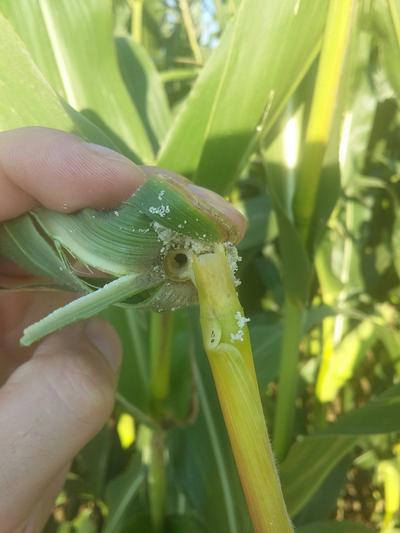European Maize Borer
Ostrinia nubilalis
Insect
In a Nutshell
- Larvae tunnel into the midrib of leaves. They produce a characteristic shot hole damage pattern. Boring damage may weaken the plant to cause subsequent stalk breakage, or the plant may become stunted, resulting in yield reductions.
Can also be found in
Symptoms
The larvae damage all aerial parts of the plant. They feed inside whorls or midribs first, and tunnel into the stalks at the base of the plant, silk and ears later. They destroy internal tissues that transport water and nutrients, leading to stunted growth, fewer leaves and lower productivity. The tunneling of the stalk weakens the bearing capacity of the plant and favors lodging. The ears have round holes with wet frass, damaged kernels, and they may drop. The holes are used by opportunistic fungi to colonize the plant, with the consequent development of rot in those tissues. The toxins produced by these fungi further worsen the quality of the yield.
Recommendations

Organic Control
Controlling european corn borer populations with predators, parasitoids and bio-insecticides is possible. Native predators include insidious flower bugs (Orius insidiosus), green lacewings and several ladybirds. Birds can also eliminate 20 to 30% of the overwintering larvae. Parasitoids include the tachinid fly Lydella thompsoni and wasps of the species Eriborus terebrans, Simpiesis viridula and Macrocentris grandii. Bio-insecticides based on Spinosad or Bacillus thuringiensis also work.

Chemical Control
Numerous insecticides can be used to control borer populations. They have to be applied in a timely manner. Granular formulations are preferred. Products containing cyfluthrin, esfenvalerate can be spayed on whorls and developing ears. Synthetic pyrethroids can also be used for this purpose.
What caused it?
The larvae overwinter in crop debris in the soil and emerge in the spring. The adults of the European maize borer are active during the night. Male moths have a thin body with brown tinges, and tan-to-brown wings with yellow serrated patterns. Females are thinner, yellowish brown with several darker zigzagging bands across the wings. They lay white egg masses on the underside of leaves, usually when the wind is calm and temperatures are warm. Larvae are dirty white to pinkish tan, with smooth, hairless skin and dark spots all over their bodies. Their head is dark brown to black. They feed on an array of weeds and alternative hosts such as soybeans, peppers and tomatoes. Low humidity, low nighttime temperatures, and heavy rain are detrimental to egg-laying and the survival of the borer.
Preventive Measures
- Use tolerant varieties if available.
- Plant early to avoid peak populations of the pest.
- Regularly monitor the fields and use traps to avoid population build-up.
- Ensure a good weed management in and around the field.
- Plow deep to dig the pupae overwintering in the soil and the plant residues.
- Rotate with non-host crops to break the life cycle of the pest.



